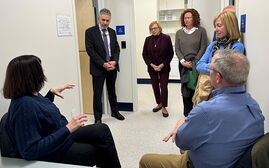Researchers will look into co-existence of offshore wind power, fisheries off Maine coast
 Courtesy / DNV, Governor’s Energy Office
Fishing operations are the focus of the state’s initial research related to offshore wind in the Gulf of Maine.
Courtesy / DNV, Governor’s Energy Office
Fishing operations are the focus of the state’s initial research related to offshore wind in the Gulf of Maine.
Fishing operations and fishing communities along Maine’s coast are the focus of the state’s initial research related to the development of offshore wind power in the Gulf of Maine.
The Governor's Energy Office said it has contracted with two entities to carry out the research on behalf of the Maine Offshore Wind Research Consortium, beginning this year.
ERM Consulting & Engineering, in partnership with the Gulf of Maine Research Institute in Portland, will explore approaches to how fisheries may coexist with floating offshore wind turbines.
ERM is a global consultancy with experience assessing the environmental and socioeconomic impacts of floating offshore wind on commercial fishing communities. GMRI will offer local knowledge and connections to Maine fishing communities, and has experience leading stakeholder meetings to gather input on draft wind areas proposed by the federal Bureau of Ocean Energy Management.
The proposed wind-power area has a power production capacity of over 40 gigawatts, which is enough electricity to supply more than 13 million homes. Karp Strategies, in partnership with Alison Bates at Colby Coilege, will create a baseline inventory of socioeconomic data pertaining to Maine’s fishing communities.
Karp Strategies is a certified urban planning and consulting firm that leverages their expertise in sustainability, community and economic development, and stakeholder engagement to promote inclusive, equitable, and sustainable initiatives.
Bates brings experience researching public perceptions of offshore wind.
The two research topics were identified by the research consortium’s advisory board, an assembly of fisheries, wildlife, marine science and industry professionals advising Maine's offshore wind research. The state is investing nearly $400,000 in research to guide floating offshore wind in the Gulf of Maine, a key recommendation of the Maine Offshore Wind Roadmap.
Priorities include pathways to coexistence between fisheries and offshore wind as well as potential social and ecological impact of offshore wind development.
In total, the Governor’s Energy Office is making nearly $1.2 million available for research.
In the coming months, Maine will seek more proposals for research to address additional topics identified by the advisory board, including a mapping project with opportunities for commercial fishing vessel support.
The Maine Offshore Wind Roadmap is an 18-month stakeholder-driven comprehensive plan that offers strategies to develop an offshore wind industry in Maine.
Ongoing efforts
The consortium was established by LD 1619, a bill signed by Gov. Janet Mills in 2021, and is coordinated by the Governor’s Energy Office, Department of Marine Resources and Department of Inland Fish and Wildlife.
The Governor’s Energy Office has said that Maine is an ideal place to responsibly develop an offshore wind industry, due to an abundant wind resource off Maine’s shores, a growing demand for renewable energy sources to reduce fossil fuels and fight climate change, an enterprising citizenry with maritime experience, and an innovative research environment with more than a decade of experience with floating offshore wind,
The Governor’s Energy Office released the roadmap a year ago, as a plan that offers detailed strategies for Maine to realize economic, energy and climate benefits from offshore wind, in conjunction with communities, fisheries and wildlife around the Gulf of Maine
According to the plan, 80 Maine companies are engaging in the U.S. offshore wind industry and the industry could generate more than $100 billion in private investment by 2030.
The federal Bureau of Ocean Energy Management last year identified a 15.2-square-mile area of federal waters, about 23 miles from Monhegan Island and 45 miles off Portland, to site research wind array with up to 12 turbines placed on floating concrete platforms pioneered by the University of Maine. The lease is intended to allow researchers to study interactions of the array with the marine environment, fishing industry, shipping and navigation routes.
Maine fishermen have registered concerns about the potential effects of offshore wind power on their industry.
In response, the federal government mapped out where future offshore wind power turbines may be placed in the Gulf of Maine so that they skirt critical lobstering and fishing grounds.
The 2021 law prohibits construction of offshore wind-power sites within Maine waters, as part of a plan to push the electricity generators farther out to sea into federally controlled areas. The law was crafted in response to concerns from Maine fishermen about the potential impact of offshore wind projects on their industry.
Up to 75% of Maine’s commercial lobster harvesting occurs in state waters
The Maine Offshore Wind Initiative, a multifaceted approach to offshore wind development in Maine, was launched by Mills in 2019 and overseen by the Governor’s Energy Office.
Since then, the pace of the offshore wind in the U.S. has accelerated as clean energy generation targets set by the federal government and many states increase demand for commercial-scale projects in deep federal waters, where it’s expected that floating platform technology will likely be required.














0 Comments